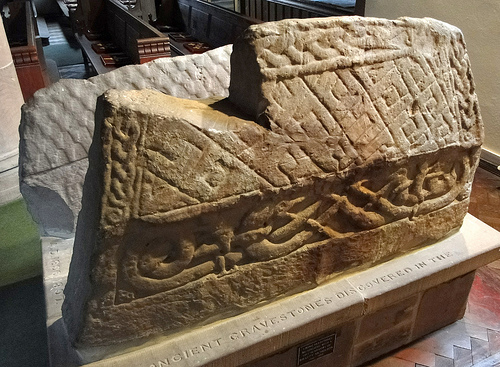This is a brief overview of a number of volumes dealing with runes, medieval memorial carvings and stone sculpture that have been published over the past months.
Readers’ comments and reviews are welcome, as are announcements about new publications that are of interest to scholars of runes, monuments and memorial carvings.




Situne Dei 2013
Contains a number of contributions about runestones, by Anne-Sofie Gräslund,Magnus Källström, Helmer Gustavson and Roger Wikell.
More information, table of contents and downloads
Raising the Dead: Early Medieval Name Stones in Northumbria
By C. Maddern
This is the first work to explore and explain the form, function and theological meaning of Northumbrian name stones, both in their immediate Insular setting and within a wider European context.
This is the first work to explore and explain the form, function, and theological meaning of Northumbrian name stones, both in their immediate Insular setting and within a wider European context. Earlier studies have concentrated on the archaeological and epigraphic aspects of these monuments, which has resulted in a tentative dating framework but also a blanket designation of ‘gravestones’. This book challenges the assumptions behind this designation and focuses on the iconography of name stones as a reflection of theological ideas of the period, based on a central hypothesis that many emulate the format of manuscript pages.
The author also addresses the contentious question of the placing of name stones, in particular whether some stones were actually placed in the grave. Her analysis presents not only evidence of differential burial practices within the same Northumbrian cemeteries, but offers parallel examples from other monastic sites in both Britain and the Continent — and significantly broadens the field of argument about early medieval burial practices. In this book, the author combines approaches from ecclesiastical history and iconography, theology, and archaeology to draw out the significance of the Northumbrian name stones and to explore the ‘living’ presence of the dead in early medieval religious communities.
More information and table of contents
Sacred Sites and Holy Places: Exploring the Sacralization of Landscape through Time and Space
Edited by S.W. Nordeide and S. Brink
In this volume two important veins of interdisciplinary research into the medieval period in Scandinavia and the Baltic region are merged, namely the Christianization process and landscape studies. The volume authors approach the common theme of sacrality in landscape from such various viewpoints as archaeology, philology, history of religion, theology, history, classical studies, and art history. A common theme in all articles is a theoretical approach, complemented by illustrative case studies from the Scandinavian, Baltic, or Classical worlds. Aspects of pagan religion, as well as Christianity and the establishment of the early Church, are considered within both geographical setting and social landscape, while the study of maps, place names, and settlement patterns introduces new methodologies and perspectives to expose and define the sacral landscape of these regions. The contributions are put into perspective by a comparison with research into the sacral landscapes of Central Europe and the Classical world.
New interdisciplinary research methods and new models have been developed by the contributors to present new vistas of sacrality in the Scandinavian and the Baltic landscape. To open up these case studies, a selection of over sixty images and maps accompanies this cutting-edge research, allowing the reader to explore sacralization and the Christianization process within its medieval setting.
More information and table of contents
Schreibpraktiken und Schriftwissen in südgermanischen Runeninschriften: Zur Funktionalität epigraphischer Schriftverwendung
By Michelle Waldispühl
Südgermanische Runeninschriften befinden sich auf mobilen Gegenständen wie Fibeln oder Waffen und datieren vorwiegend aus dem 6. Jahrhundert. Unter den Inschriften gibt es auffällig viele ohne sprachliche Botschaft: die Runenschrift wurde lediglich imitiert. Welche Botschaft sollte mit ihnen vermittelt werden? Wie sind sie im damaligen Schriftverständnis zu verorten?
Die vorliegende Studie beleuchtet die Funktionalität runenepigraphischer Schrift im Kontext sozialen Handelns, insbesondere im Zusammenhang mit den Trägerobjekten, unter Berücksichtigung der Techniken der Schriftanbringung, der visuellen Ausprägung von Schrift und interaktiv-kommunikativer Bedingungen.
Es zeigt sich, dass das sprachliche wie auch das visuelle Potential von «Schrift» in der südgermanischen Runenkultur selten isoliert vom Trägerobjekt funktioniert, weshalb Inschriften ohne sprachliche Botschaft in Teilen genauso aussagekräftig sein konnten wie solche mit.
Diese mit umfassendem Bildteil versehene Arbeit bietet zusätzlich eine Systematisierung der runologischen Methodik zur schreibtechnischen, graphematischen und kontextuellen Untersuchung der Inschriften.
More information and table of contents
Epigraphic Literacy and Christian Identity: Modes of Written Discourse in the Newly Christian European North
Edited by K. Zilmer and J. Jesch
This collection of nine essays deals with the role of epigraphic literacy within the newly introduced Christian culture and the developing tradition of literacy in Northern Europe.
This volume examines the role of epigraphic literacy within the newly introduced Christian culture and the developing tradition of literacy in Northern Europe during the Viking Age and the High Middle Ages. The epigraphic material under scrutiny here originates from Scandinavia and North-West Russia – two regions that were converted to Christianity around the turn of the first millennium. Besides traditional categories of epigraphic sources, such as monumental inscriptions on durable materials, the volume is concerned with more casual inscriptions on less permanent materials. The first part of the book discusses a form of monumental epigraphic literacy manifested on Scandinavian rune stones, with a particular focus on their Christian connections. The second part examines exchanges between Christian culture and ephemeral products of epigraphic literacy, as expressed through Scandinavian rune sticks, East Slavonic birchbark documents and church graffiti. The essays look beyond the traditional sphere of parchment literacy and the Christian discourse of manuscript sources in order to explore the role of epigraphic literacy in the written vernacular cultures of Scandinavia and North-West Russia.
More information and table of contents
Futhark 3
Was already available online, and now also as printed volume.
Order printed copies of Futhark and Scripta Islandica
Dowload Furthark articles as pdf
Memories in the Making
On his blog, Howard Williams offers a sneak preview of a volume about early medieval inscribed and sculpted stone monuments that Meggen Gondek, Joanne Kirton and he are currently preparing.




